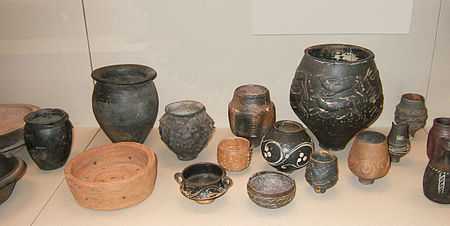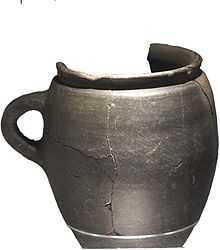Black-burnished ware

Black-burnished ware is a type of Romano-British ceramic. It comprises wheel-thrown grey or black sand-tempered wares, typically everted-rim jars with burnished lattice decoration, bead-rim and plain dishes. There are two sub-types of the Black-burnished ware fabric. Black burnished ware 1 (BB1), produced in Dorset, was a black, coarse and gritty fabric widely distributed from AD 120 to the late 4th century. Black burnished ware 2(BB2) is a finer, grey-coloured, wheel thrown fabric produced at sites around the Thames Estuary (Kent and Essex) and distributed in south-east England and in northern Britain from 120 AD to the mid 3rd century.[1]
Black Burnished Ware

Black burnished ware is a type of Romano-British ceramic. It is also known as “common black (or gray) ware” and also “fumed ware.”[2] Black burnished ware is “manufactured in two different fabrics” and takes a form that is typical for culinary vessels.[1] Black burnished ware also comes in two different categories that are based upon the location of where the ware was created and the components of the clay body as well as how it is made (such as by hand or wheel-thrown even though one way does not strictly belong to one category or the other). The categories are named Black Burnished Ware Category 1 (BB1) and Black Burnished Ware Category 2 (BB2).
Decoration on both categories consists of everted-rims with burnished lattice design on the body. Plain dishes are also known.
Black Burnished Ware 1
Black Burnished Ware Category 1 (BB1) is made from a clay body that has a coarse texture. The clay body can contain black iron ores, flint, quartz, red iron ores, shale fragments, and white mica.[3] BB1 can be grainy and black or dark gray in appearance. These wares are formed by hand.
BB1 wares were manufactured in the Dorset area and distributed throughout Britain.[4] The distribution of BB1 wares dates primarily to the mid-second to fourth centuries AD. Forms include bowls, dishes, and jars.[3]
Black Burnished Ware 2
Black Burnished Ware Category 2 (BB2) is greyer in color and has a finer texture when compared with BB1.[1] It is a “hard, sandy fabric, varying in colour from dark-grey or black with a brown or reddish brown core and a reddish-brown, blue-grey, black or lighter ('pearly grey') surface.”[5] The clay body can contain black iron ore, mica, and quartz, all in a matrix of sediment.[5] BB2 is wheel-thrown rather than hand-formed.
BB2 wares were manufactured in the area of the Thames Estuary.[6][7] The distribution of BB2 wares occurred from AD 140 through to the mid third century AD in south-east England and the northern part of Britain.[5]
References
- ↑ 1.0 1.1 1.2 Darvill, T. (2003). Concise Oxford Dictionary of Archaeology. ISBN 9780192800053.
- ↑ Farrar, R. A. H. 1973. The techniques and sources of Romano-British black-burnished ware. S.l: s.n.].
- ↑ 3.0 3.1 Tyers, P A. "South-east Dorset black-burnished 1." Potsherd. Accessed February 21, 2011. Last modified December 28, 2010. http://potsherd.net/.
- ↑ Allen, J R L, and M G Fulford. "The Distribution of South-East Dorset Black Burnished Category I Pottery in South-West Britain." Britannia 27 (1996): 223-281. Accessed February 21, 2011. http://www.jstor.org/stable/527045.
- ↑ 5.0 5.1 5.2 Tyers, P A. "Black-burnished 2." Potsherd. Accessed February 21, 2011. Last modified December 28, 2010. http://potsherd.net/.
- ↑ Catherall, P D, R J Pollard, R C Turne, and M A Monk. "A Romano-British Pottery Manufacturing Site at Oakleigh Farm, Higham, Kent." Britannia 14 (1983): 103-141. Accessed February 15, 2011. http://www.jstor.org/stable/526344.
- ↑ Upchurch ware" The Concise Oxford Dictionary of Archaeology. Timothy Darvill. Oxford University Press, 2008.Oxford Reference Online. Oxford University Press. Mary Baldwin College. 22 February 2011 <http://www.oxfordreference.com/views/ENTRY.html?subview=Main&entry=t102.e4435>